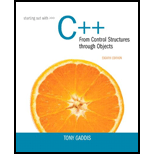
Starting Out with C++ from Control Structures to Objects (8th Edition)
8th Edition
ISBN: 9780133769395
Author: Tony Gaddis
Publisher: PEARSON
expand_more
expand_more
format_list_bulleted
Concept explainers
Expert Solution & Answer
Chapter 18, Problem 1RQE
Explanation of Solution
LIFO:
LIFO stands for “Last In First Out”.
- The item which is inserted at last, can be retrieved first.
- The example for LIFO implementation is “stack” which is a type of container.
- The elements can be inserted and retrieved at any one end of the stack. A stack can perform two operations. They are:
- Push – Inserting an element inside a stack.
- When the first element is pushed into the stack, the element will be at the “top” the stack. When the second element is added, the first element is pushed down and the second element will be at the top position, like this it goes on until the element which pushed at last will be at the top of the stack.
- Pop – Deleting an element from the stack.
- The element which is inserted at last will be deleted first.
- Push – Inserting an element inside a stack.
Example: Cookies in a container.
The baker arranges the cookies one by one in a container in which the lastly inserted cookie is taken out first from the container.
Want to see more full solutions like this?
Subscribe now to access step-by-step solutions to millions of textbook problems written by subject matter experts!
Students have asked these similar questions
I need to define and discuss the uses of one monitoring or troubleshooting tool in Windows Server 2019. thank you
I would likr toget help with the following concepts:
- Windows Server features
- Windows Server versus Windows 10 used as a client-server network
I need to define and discuss the uses of one monitoring or troubleshooting tool in Windows Server 2019. thank you
Chapter 18 Solutions
Starting Out with C++ from Control Structures to Objects (8th Edition)
Ch. 18.3 - Describe what LIFO means.Ch. 18.3 - What is the difference between static and dynamic...Ch. 18.3 - What are the two primary stack operations?...Ch. 18.3 - What STL types does the STL stack container adapt?Ch. 18 - Prob. 1RQECh. 18 - Prob. 2RQECh. 18 - What is the difference between a static stack and...Ch. 18 - Prob. 4RQECh. 18 - Prob. 5RQECh. 18 - The STL stack is considered a container adapter....
Ch. 18 - What types may the STL stack be based on? By...Ch. 18 - Prob. 8RQECh. 18 - Prob. 9RQECh. 18 - Prob. 10RQECh. 18 - Prob. 11RQECh. 18 - Prob. 12RQECh. 18 - Prob. 13RQECh. 18 - Prob. 14RQECh. 18 - Prob. 15RQECh. 18 - Prob. 16RQECh. 18 - The STL stack container is an adapter for the...Ch. 18 - Prob. 18RQECh. 18 - Prob. 19RQECh. 18 - Prob. 20RQECh. 18 - Prob. 21RQECh. 18 - Prob. 22RQECh. 18 - Prob. 23RQECh. 18 - Prob. 24RQECh. 18 - Prob. 25RQECh. 18 - Prob. 26RQECh. 18 - Write two different code segments that may be used...Ch. 18 - Prob. 28RQECh. 18 - Prob. 29RQECh. 18 - Prob. 30RQECh. 18 - Prob. 31RQECh. 18 - Prob. 32RQECh. 18 - Prob. 1PCCh. 18 - Prob. 2PCCh. 18 - Prob. 3PCCh. 18 - Prob. 4PCCh. 18 - Prob. 5PCCh. 18 - Dynamic String Stack Design a class that stores...Ch. 18 - Prob. 7PCCh. 18 - Prob. 8PCCh. 18 - Prob. 9PCCh. 18 - Prob. 10PCCh. 18 - Prob. 11PCCh. 18 - Inventory Bin Stack Design an inventory class that...Ch. 18 - Prob. 13PCCh. 18 - Prob. 14PCCh. 18 - Prob. 15PC
Knowledge Booster
Learn more about
Need a deep-dive on the concept behind this application? Look no further. Learn more about this topic, computer-science and related others by exploring similar questions and additional content below.Similar questions
- Please solve and answer the questions correctly please. Thank you!!arrow_forwardConsidering the TM example of binary sum ( see attached)do the step-by-step of execution for the binary numbers 1101 and 11. Feel free to use the Formal Language Editor Tool to execute it; Write it down the current state of the tape (including the head position) and indicate the current state of the TM at each step.arrow_forwardI need help on inculding additonal code where I can can do the opposite code of MatLab, where the function of t that I enter becomes the result of F(t), in other words, turning the time-domain f(t) into the frequency-domain function F(s):arrow_forward
arrow_back_ios
SEE MORE QUESTIONS
arrow_forward_ios
Recommended textbooks for you
 Systems ArchitectureComputer ScienceISBN:9781305080195Author:Stephen D. BurdPublisher:Cengage Learning
Systems ArchitectureComputer ScienceISBN:9781305080195Author:Stephen D. BurdPublisher:Cengage Learning C++ Programming: From Problem Analysis to Program...Computer ScienceISBN:9781337102087Author:D. S. MalikPublisher:Cengage Learning
C++ Programming: From Problem Analysis to Program...Computer ScienceISBN:9781337102087Author:D. S. MalikPublisher:Cengage Learning New Perspectives on HTML5, CSS3, and JavaScriptComputer ScienceISBN:9781305503922Author:Patrick M. CareyPublisher:Cengage Learning
New Perspectives on HTML5, CSS3, and JavaScriptComputer ScienceISBN:9781305503922Author:Patrick M. CareyPublisher:Cengage Learning- Np Ms Office 365/Excel 2016 I NtermedComputer ScienceISBN:9781337508841Author:CareyPublisher:Cengage
 C++ for Engineers and ScientistsComputer ScienceISBN:9781133187844Author:Bronson, Gary J.Publisher:Course Technology Ptr
C++ for Engineers and ScientistsComputer ScienceISBN:9781133187844Author:Bronson, Gary J.Publisher:Course Technology Ptr

Systems Architecture
Computer Science
ISBN:9781305080195
Author:Stephen D. Burd
Publisher:Cengage Learning

C++ Programming: From Problem Analysis to Program...
Computer Science
ISBN:9781337102087
Author:D. S. Malik
Publisher:Cengage Learning

New Perspectives on HTML5, CSS3, and JavaScript
Computer Science
ISBN:9781305503922
Author:Patrick M. Carey
Publisher:Cengage Learning


Np Ms Office 365/Excel 2016 I Ntermed
Computer Science
ISBN:9781337508841
Author:Carey
Publisher:Cengage

C++ for Engineers and Scientists
Computer Science
ISBN:9781133187844
Author:Bronson, Gary J.
Publisher:Course Technology Ptr